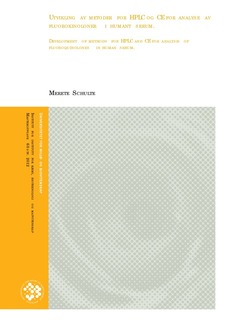| dc.description.abstract | Hensikten med denne oppgaven var å teste ut og evaluere to metoder for å analysere noen utvlagte fluorokinoloner i humant serum ved hjelp av væskekromatografi, HPLC, og kapillærelektroforese, CE.
Det ble testet ut to separasjonsbuffere, en tetraboratbuffer og en fosfatbuffer. Tetraboratbuffer oppnådde ikke tilstrekkelig separasjon.
En oppkonsentreringteknikk som «LVSS» ble testet ut med 20 μM norfloksacin. Med denne teknikken ble det oppnådd en signaløkning som var 34x bedre enn med «normal mode stacking».
En analyse av fluorokinolonene med 50 mM fosfatbuffer/AcN (60:40, v/v), pH 7,57 gav best separasjon, men den var ikke fullstendig. Migrasjonstidene er stabile, men arealene av toppene er ustabile. Kapillærelektroforese er ikke egnet for kvantitative forsøk. Systemet viste ikke god nok robusthet.
I metodeutviklingen i HPLC ble ulike sammensetninger og kolonner testet ut. Den kolonnen som gav optimal separasjon av analyttene var med ACE 3, C18-HL kolonne med 25 mM fosfatbuffer/MeOH (75:25, v/v) (TEA, pH 3,03). Analysetidene var under 10 minutter for alle fluorkinolonene. De kromatografiske beregningene av den optimale separasjonen tilfredsstiller kravene for god analytisk separasjon. Metoden var rask og systemet viste god robusthet.
Med disse analysebetingelsene ble et kvantitativt forsøk utført der fluorokinolonene ble tilsatt humant serum. Dette gav resultater med 90 % gjenfinning av analyttene. The goal of this study was to test and evaluate two different methods for analyzing selected flouroquinolones in human serum with the help of liquid chromatography, HPLC and capillary electrophoresis.
Two different separation buffers, one tetraborate buffer and one phosphate buffer were tested.
An on-line sample preconcentration technique, LVSS, was tested with 20 μM norfloxacin. A signal improvement of 34x compared to normal mode stacking was achieved with this technique.
An analysis of the fluoroquinolones with 50 mM phosphate buffer/AcN (60:40, v/v); pH 7.57 gave the best separation, though it was not an entire separation. The migration times are reproducible in repeated tests, but the areas of the peaks vary. Capillary electrophoresis is unsuited for quantitative analysis. The system was not sufficiently robust.
Three columns and three different buffer combinations were tested in the methodological development in HPLC. The column that gave optimal separation of the compounds was with ACE 3, C18-HL column with 25 mM phosphate buffer/MeOH (75:25, v/v) (TEA, pH 3.03). The analysis times were under 10 minutes for all the fluoroquinolones. The chromatographic calculations were based on the optimal separation.
Within this analytical condition, a quantitative experiment was performed in which fluoroquinolones were added to human serum. This resulted in a 90 % recovery of the analyzed compounds. | no_NO |
